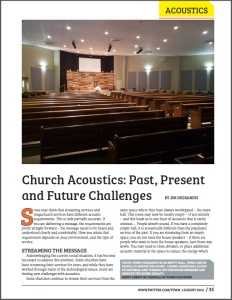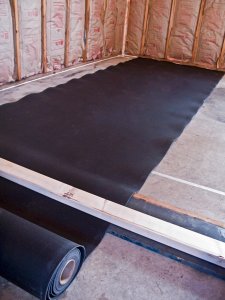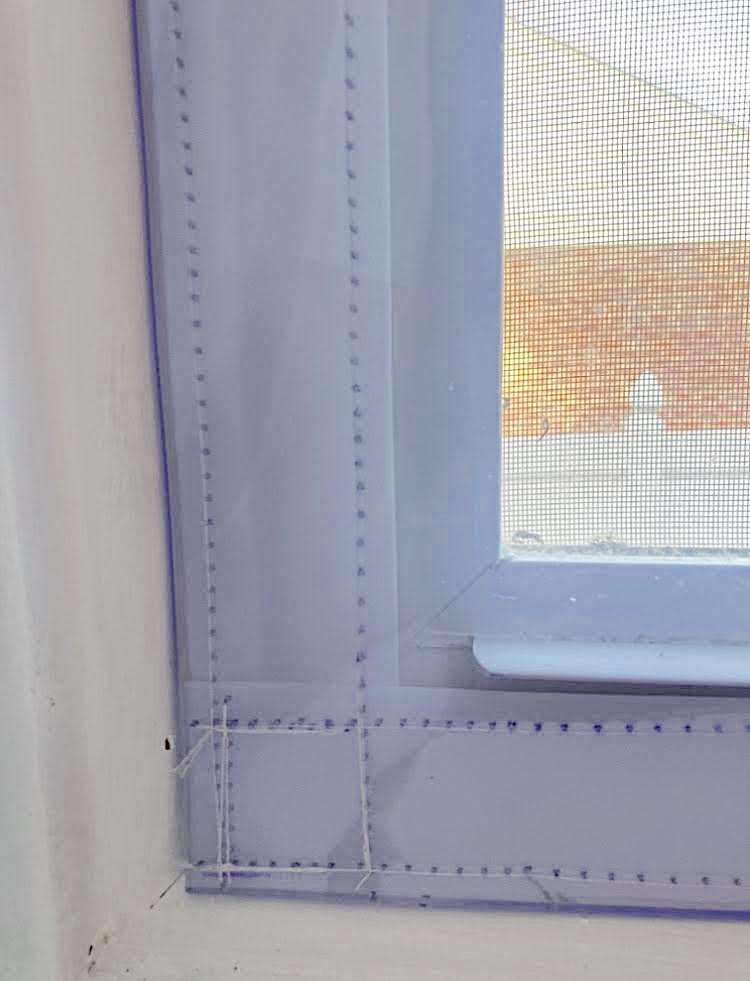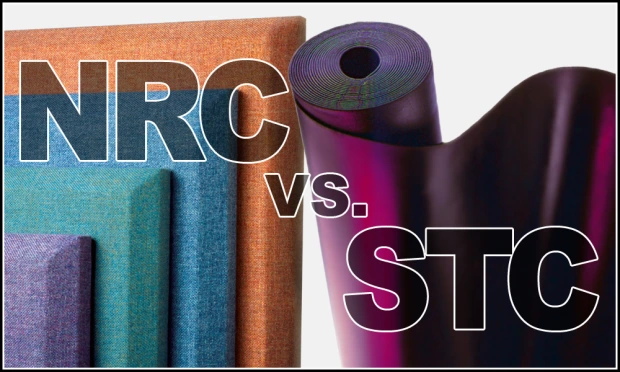Archive for category Sound proofing
Church Acoustics: Past, Present, and Future Challenges (Article)
Posted by Acoustics First in Absorption, Articles, Broadcast Facilities, HOW TO, Product Applications, Products, Sound proofing, Worship Facilities on October 28, 2020
With all of the challenges of 2020, Technologies for Worship Magazine wanted to discuss the issue of acoustics in the current state of things. They approached Acoustics First® for help. While focusing on streaming, the article also covers other emerging issues and future challenges as we all move forward.

Streaming services from empty halls is an often overlooked situation. (Sonora® Panel installation at Midway Christian Church – Photo by Bo Vandall, Sound Solutions – Beckley, WV)
Technologies for Worship article below.
 Link to Acoustics First® Article
Link to Acoustics First® Article
(TFWM site here)
To overcome your present and future acoustic challenges, contact Acoustics First® for help!
Demystifying Acoustic Data: Part 3 – Perception of Volume
Posted by Acoustics First in Product Applications, Sound proofing, Uncategorized on June 16, 2017
 For anyone new to the world of acoustics, there is a multitude of terms, coefficients and numbers that are thrown around. This flood of information can seem intimidating, especially to beginners. In this series, acoustician Cameron Girard of Acoustics First® hopes to help you distinguish between what’s useful and what’s not.
For anyone new to the world of acoustics, there is a multitude of terms, coefficients and numbers that are thrown around. This flood of information can seem intimidating, especially to beginners. In this series, acoustician Cameron Girard of Acoustics First® hopes to help you distinguish between what’s useful and what’s not.
Part 3: Perception of Volume
Our ears are wonderful and intricate tools that many of us take for granted. It is very important to understand the idiosyncrasies of our hearing when considering the effect a certain acoustic treatment will make. For starters, let’s take a look at how our ears interpret volume.
Volume (Sound Intensity)
Sound levels (i.e. how loud something is) are typically expressed in decibels (dB). Human hearing ranges from 0dB (threshold of hearing) to 130dB (threshold of pain). The following chart displays common sound sources and their typical dB level.
Do two candles really burn twice as bright?
If one trombonist plays at 70dB, how much louder would it be if another trombonist started playing at 70dB? One might assume that the two trombonists combined would play at 140 dB, but this is not the case. Since decibels are logarithmic values, they cannot be combined by normal algebraic addition. When two sources at the same level play, 3dB should be added to the value to find the combined sound level. So in adding another trombonist, you would really only increase the level to 73dB, a much smaller jump than expected.
“Doubling” the amount of players will double the acoustic power, but what do we actually hear? The loudness perception table shown below displays how these decibel changes are actually perceived by the listener.
|
Loudness Perception Table |
|||
| Change of Level | Approx. Perceived Difference | Volume Gain Factor | Acoustic Power Gain Factor |
| +10dB | “twice as loud” | 2.000 | 10.000 |
| +6dB | “significantly louder” | 1.516 | 4.000 |
| +3dB | “noticeably louder” | 1.232 | 2.000 |
| ±0 | “no change” | 1.000 | 1.000 |
| – 3dB | “noticeably quieter” | 0.812 | 0.500 |
| – 6dB | “significantly less loud/noisy” | 0.660 | 0.250 |
| – 10dB | “half as loud” | 0.500 | 0.100 |
*Chart Courtesy of David Eagan’s Architectural Acoustics (New York: McGraw-Hill, 1988),
As you can see, doubling the acoustic power (a change of 3dB) would be “noticeable” but not “significant”. It would take a jump of 10dB to make something sound twice as loud. Keep this chart in mind when reviewing acoustic predictions, particularly those that that pertain to noise reduction/control and sound isolation.
Demystifying Acoustic Data: Part 1 – Absorption vs Isolation
Posted by Acoustics First in Absorption, Articles, Product Applications, Products, Sound proofing, Video on August 16, 2016
For anyone new to the world of acoustics, there is a multitude of terms, coefficients and numbers that are thrown around. This flood of information can seem intimidating, especially to beginners. In this series, acoustician Cameron Girard of Acoustics First® hopes to help you distinguish between what’s useful and what’s not.
Part 1: Acoustic Terminology – Sound Absorption vs Sound Isolation
In order to make informed decisions about acoustical treatment, it is vital to know the difference between materials that are meant to absorb sound within a room and materials that are meant to block sound from leaving or entering it. In an overly reverberant auditorium, absorptive treatment is needed to reduce echoes and improve speech intelligibility. If the problem is sound passing in between spaces, like offices or apartments, then isolation treatment is required. These are two separate acoustic issues which require separate solutions.
In both scenarios, it is important to know which data is relevant and helpful. Also, given sheer volume of information available on the internet, it is perhaps unavoidable that some info will be incomplete or simply incorrect. It should not be assumed that something which sounds technical is, in fact, backed up by proper testing.
Terms for Sound Absorption
We recently encountered an acoustical ceiling tile which was said to “absorb 50% of sound”. On the surface this sounds like an extremely efficient product. However, let’s delve in closer and decipher what is actually usable information, and what is just marketing.
When sound waves meet a room surface such as a wall, ceiling or floor, some of the sound energy is reflected back into the room and the rest is considered to be “absorbed”. The absorbed sound energy has not vanished, it’s actually been converted into kinetic (vibration of a solid material) and thermal energy (heat due to friction within a porous material) or has simply passed right through the material (transmission). The more surface area a certain material has the better absorber it will likely be. “Soft” materials, like heavy blankets, fabric and fiberglass, have loads of nooks and crannies, which sound tries to “fill”. These porous materials are great for reducing reverberation within a room, but will only marginally reduce the sound that leaves it (but more on that later).

Sonora® wall and ceiling panels are used for absorbing sound within a space.
When comparing sound absorbing products, there is a particular set of terms you should look for: The Sound Absorption Coefficient (SAC) and Noise Reduction Coefficient (NRC). These are used to specify the fraction of incident sound that a material absorbs per 1’x1’ area. An NRC of 1.0 indicates perfect absorption (an open 1’x1’ window) and a value of 0.0 represents perfect reflection (polished concrete has an NRC of .02).
To measure sound absorption, a large sample of the material is placed in a reverberation room with all other surfaces being hard and reflective. The time it takes a test sound signal to decay by 60dB (rough point of inaudibility) after the source of sound is stopped is measured first with the sample in the room and again with the room empty. The difference in decay time defines the efficiency of the absorbing material and thus the absorption coefficients. Large spaces with low-NRC materials (tile, drywall, etc.) have longer reverberation times, while small rooms furnished with high-NRC materials sound much more “dead”.
Clearly, a single 2’x2’ ceiling tile is not going to reduce the reverberation in a real-world space by 50%. So is the above claim false? Not exactly… The ceiling panels do have an NRC rating of .50, so the tile does absorb 50% of incident sound. However, one might assume a much more drastic improvement based on the “50%” claim. In reality you’d need a large square footage of these ceiling tiles to cut the amount of total reflected sound in half. Always be sure to check the NRC number!
Terms for Sound Isolation
Our customers often call with issues related to neighbor noise or office-to-office privacy and are looking for “sound proofing” treatment. Unfortunately, many do not realize that simply installing acoustic foam or fiberglass panels will not appreciably reduce the level noise entering and leaving their space. These absorptive materials are great at reducing unwanted reflections within a room because they are porous and air/sound energy can flow through them. That being said, they are generally poor sound barriers for this exact reason. They will help to reduce noise buildup in a room and improve the ‘acoustics’, but will do very little to “block” sound coming in or out.

BlockAid® is a heavy, impermeable barrier for stopping the transmission of sound.
Sound is like water; it will “flow” into an adjacent space if everything isn’t sealed up. Materials that are air tight and heavy, like our BlockAid® sound barrier, provide the most relief of air-born sound transmission. Continuous coverage of floors/ceilings or walls is necessary to ensure that sound doesn’t ‘flank’ around these barriers. Multiple layers of varying materials, the use of resilient clips or channels, and additional walls will provide even more control. For a demonstration of how different materials affect sound isolation, check out our video http://acousticsfirst.com/educational-videos-the-barrier-and-the-bell.htm
Like NRC for sound absorption, there is also a laboratory tested figure that can be used to compare the sound “blocking” properties of acoustic barriers and wall constructions: Transmission Loss (TL) and Sound Transmission Class (STC). These describe how much air-born sound is attenuated through a given material.
In the lab, the material to be tested is mounted over an opening between two completely separated rooms, one with a speaker (source) and the other with a microphone (receiver). Save for the open “window”, these rooms are completely isolated with thick and massive walls, so virtually all the sound energy transmitted between rooms will be through the test specimen. The difference between sound levels in the source room and the receiving room is the transmission loss (TL). The TL is measured at multiple frequencies, which is fitted to a Sound Transmission Class (STC) “curve” at speech frequencies (125Hz-4kHz). The STC of the material is the TL value of the fitted curve at 500 Hz. For example, a material with an STC of 27 typically “blocks” 27dB of sound. Keep in mind though, the STC’s of materials do not add up linearly; in other words, adding a material with an STC of 27 to an existing wall with an STC 45 will not result in an STC of 72.
As always, Acoustics First is here answer questions and help you find the best solutions.



 For our first post of 2017, we thought we’d share this video produced by our friends at Graveyard Carz! When the reality show had noise issues with their compressors while filming, they solved the problem by using Stratiquilt™ Acoustic Blankets from Acoustics First®. This video shows a before and after comparison and is a great example of the practical application of these industrial sound control blankets.
For our first post of 2017, we thought we’d share this video produced by our friends at Graveyard Carz! When the reality show had noise issues with their compressors while filming, they solved the problem by using Stratiquilt™ Acoustic Blankets from Acoustics First®. This video shows a before and after comparison and is a great example of the practical application of these industrial sound control blankets.
You must be logged in to post a comment.